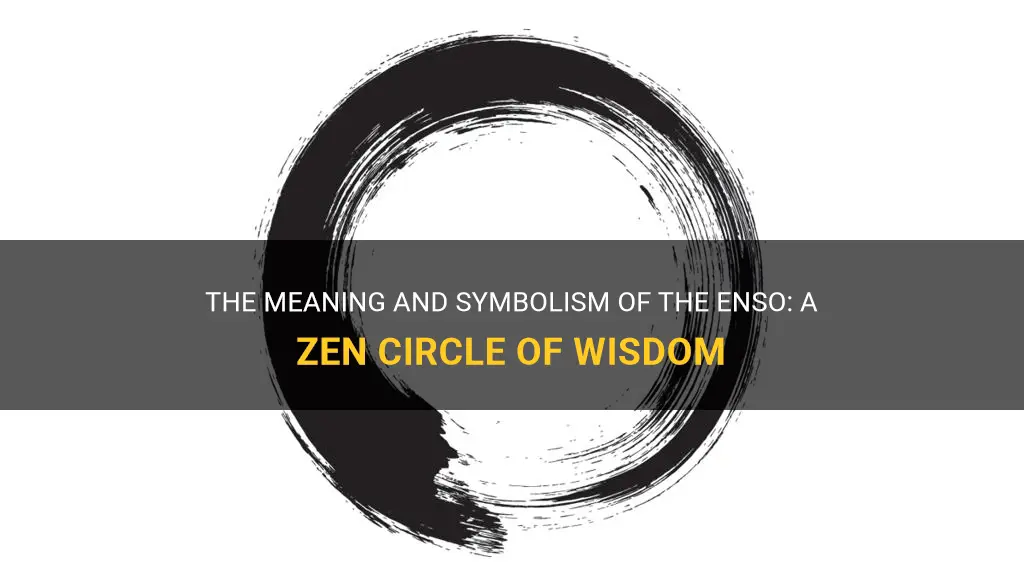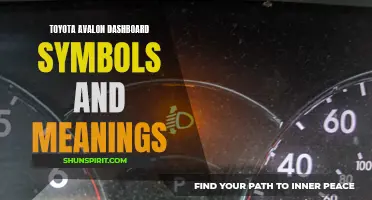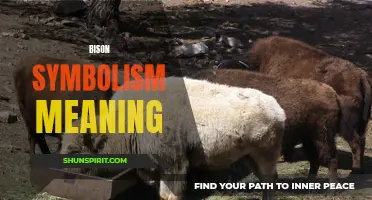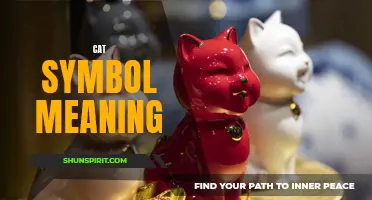
The enso symbol, a simple yet profound circle often associated with Zen Buddhism, is a symbol full of rich meaning and significance. While its appearance may be simple, the enso holds within it a depth of wisdom and philosophy that transcends words. It represents the beauty of imperfection, the eternal cycle of life and death, and the notion of embracing the present moment. In this article, we will explore the enso symbol and delve into its many layers of meaning. So, join us on this journey as we unravel the enso symbol's significance and discover the profound wisdom it offers.
What You'll Learn

What is the cultural significance of the enso symbol?
The enso symbol is a unique and highly cherished symbol in Japanese culture. It is a circular shape that is created in one fluid, brushstroke-like motion. This simplicity and imperfection of the enso is what makes it so profound and meaningful to many people.
In Japanese Zen Buddhism, the enso symbolizes enlightenment, strength, and the beauty of imperfection. It is often used as a metaphor for the universe or the circle of life. The enso can represent the fullness and emptiness of existence, the eternal flow of energy, and the interconnectedness of all things.
The enso is also seen as a symbol of individuality and self-expression. Each enso is unique, with its own shape and style, reflecting the personality and artistic expression of the person who creates it. It encourages people to embrace their uniqueness and celebrate their individuality.
Beyond its spiritual and philosophical meanings, the enso is also admired for its aesthetic beauty. The simplicity and minimalism of the enso make it a captivating symbol. Its fluid and flowing form captivate the eye and draw the viewer into a state of contemplation and introspection.
In Japanese calligraphy, the enso is often created with a bamboo brush and sumi ink, using a single stroke of the brush. This process requires concentration, precision, and a deep connection with the brushstroke. The act of creating an enso can be meditation in itself, bringing the artist into a state of calm and mindfulness.
The enso symbol has also inspired many artists and designers outside of Japan. Its minimalistic and versatile nature make it a popular motif in contemporary art, design, and even tattoos. It has become a symbol of simplicity and zen lifestyle for many people around the world.
In conclusion, the enso symbol holds great cultural significance in Japanese spirituality and art. It represents enlightenment, the circle of life, individuality, and beauty in imperfection. Its aesthetic beauty and meditative process of creation have made it a beloved symbol in both traditional and contemporary art forms. The enso continues to inspire and captivate people around the world with its deep meaning and unique beauty.
The Symbolism and Meaning Behind the 7 Sacraments in Christianity
You may want to see also

How does the enso symbol relate to Zen Buddhism?
The enso symbol is a simple, yet profound, representation of Zen Buddhism. Zen Buddhism, also known as Chan Buddhism, is a school of Mahayana Buddhism that originated in China during the Tang dynasty and spread to Japan in the 12th century. It emphasizes direct experience and meditation as a means to attain enlightenment or awakening. The enso symbol is often seen as a visual representation of this spiritual journey.
The enso symbol is a circle that is drawn in one brushstroke. It is typically painted in black ink on white paper or silk. The circle is not closed, symbolizing the imperfections and incompleteness of existence. It is often said that the enso represents the universe, with its empty middle representing emptiness or the void. This emptiness is not a negative or nihilistic concept but rather a source of potential and possibility.
In Zen Buddhism, the enso symbol is often used as a tool for meditation and contemplation. The act of drawing or viewing the enso can be a way to quiet the mind and enter a state of mindfulness. The simplicity and minimalism of the enso encourage the practitioner to let go of attachments and preconceived notions, allowing for a direct experience of the present moment.
The enso symbol is also seen as a visual representation of the Zen Buddhist concept of "mu" or "emptiness." This concept refers to the idea that all phenomena are empty of inherent existence. The enso's empty middle can be seen as a reminder of this essential truth.
Furthermore, the enso symbol is often associated with the concept of wabi-sabi, which is a Japanese aesthetic that embraces imperfection and impermanence. The enso's simple and imperfect brushstroke captures the essence of wabi-sabi, reminding us of the beauty and transience of life.
In conclusion, the enso symbol is deeply intertwined with Zen Buddhism. It serves as a visual representation of the spiritual journey towards awakening and enlightenment. The enso's simplicity and emptiness encourage a direct experience of the present moment, while its imperfections reflect the concept of wabi-sabi. Whether drawn, viewed, or contemplated upon, the enso symbol can be a powerful tool for deepening one's understanding of Zen Buddhism and cultivating mindfulness in everyday life.
Decoding the Hidden Meanings: Understanding Symbols Stamped on Jewelry
You may want to see also

What does the enso symbol represent in Japanese calligraphy?
The enso symbol is an important and highly regarded symbol in Japanese calligraphy. It is a circular brushstroke that is often depicted as an incomplete circle, with a small opening left at the top. The enso holds deep spiritual significance and is used to represent a multitude of concepts in Japanese culture.
One of the primary meanings of the enso symbol is "zen." Zen is a school of Buddhism that emphasizes the importance of direct experience and meditation. The enso is often used as a visual representation of the concept of enlightenment and the various aspects of zen practice. The incomplete circle is seen as a reflection of the imperfection and impermanence of the world, while the simplicity and unity of the brushstroke symbolize the essence of zen philosophy.
In addition to representing zen, the enso is also associated with the concepts of emptiness, enlightenment, and the interconnectedness of all things. The space within the circle is said to represent the void or emptiness that exists within all things. It symbolizes the idea that everything is interconnected and inseparable, and that there is no absolute distinction between ourselves and the world around us.
The enso is often created with a single brushstroke, done in one fluid motion. This technique requires great concentration and mindfulness, making the creation of enso a form of meditation in itself. The act of painting an enso is said to be a way of capturing a moment of clarity and reflection, and represents the artist's state of mind at the time of creation.
The enso symbol is not only significant in the practice of calligraphy, but it is also commonly used in Zen artwork, such as paintings, sculptures, and tattoos. Many Zen temples and monasteries also incorporate the enso symbol in their designs and decorations.
Overall, the enso symbol in Japanese calligraphy represents a multitude of profound concepts related to zen, enlightenment, and the interconnectedness of all things. It is a symbol that holds great spiritual significance and is used as a way to express and reflect upon these concepts in Japanese culture.
Decoding the Mystery: Demystifying Range Rover Dashboard Symbols
You may want to see also

Are there variations or different interpretations of the enso symbol?
The enso symbol, also known as the zen circle, is a traditional symbol in Japanese Zen Buddhism that represents enlightenment, strength, elegance, and the universe. It is commonly used in calligraphy and artwork, and its simple yet powerful form has captivated people for centuries. While the basic enso symbol is a single, closed circle, there are indeed variations and different interpretations of this iconic symbol.
One common variation of the enso symbol is the addition of a small opening or gap in the circle. This symbolizes the imperfection or incompleteness of existence. It reminds us that perfection is unattainable and that there will always be room for growth and improvement. This interpretation is often associated with the idea of wabi-sabi, a traditional Japanese aesthetic that values the beauty of imperfection and impermanence.
Another variation of the enso symbol is the use of different brushstrokes and calligraphy styles. The shape and thickness of the brush, as well as the speed and intention of the stroke, can greatly influence the appearance of the enso symbol. Some artists prefer a bold and powerful stroke, while others prefer a softer and more delicate approach. Each brushstroke style can convey different emotions and meanings, adding depth and richness to the symbol.
Additionally, the size and placement of the enso symbol can also vary. In some artworks, the enso is depicted as a small, subtle element within a larger composition, while in others, it is the focal point of the artwork, dominating the entire space. The size and placement of the symbol can affect its significance and impact on the viewer.
Furthermore, the enso symbol can be combined with other elements or symbols to create fusion artworks. For example, it is often combined with the lotus flower, which represents purity and enlightenment in Buddhism. This combination creates a powerful visual representation of spiritual growth and awakening.
In conclusion, while the enso symbol is usually depicted as a single, closed circle, there are indeed variations and different interpretations of this iconic symbol. These variations can include the addition of a small opening or gap, different brushstroke styles, variations in size and placement, and fusion with other symbols. Each variation adds unique nuances and meanings to the enso symbol, allowing artists and viewers to explore and appreciate its depth and versatility.
The Symbolism of the Scale: Exploring Its Meaning and Significance
You may want to see also

How has the meaning of the enso symbol evolved over time?
The enso symbol is a geometric shape commonly associated with Zen Buddhism. This simple yet profound symbol has evolved in meaning over time, reflecting the changing interpretations and cultural contexts of Zen practice.
Originating in East Asia, the enso symbol is often drawn as a circle, sometimes open and unfinished. It is typically created with a single brushstroke, representing the spontaneity and imperfection of existence. Within Zen Buddhism, the enso symbolizes enlightenment, emptiness, and the interconnectedness of all things.
In its earliest form, the enso was primarily used as a visual representation of Zen teachings to aid in meditation. It was created by Zen masters as a way to transmit complex ideas in a simple and direct manner. The enso served as a reminder to practitioners of the fundamental Buddhist concepts of impermanence, non-duality, and the illusion of self.
However, as Zen Buddhism spread to different cultures and regions, the meaning of the enso symbol began to diverge. In Japan, for example, the enso came to represent a broader set of ideas and values. It became associated with the concept of ma, which refers to the space between objects and the emptiness within. The enso symbol came to embody the Japanese aesthetic ideals of simplicity, minimalism, and beauty in imperfection.
In contemporary Western interpretations, the enso symbol is often seen as a representation of wholeness and completeness. It is viewed as a symbol of harmony, balance, and the unity of opposites. The enso can also be seen as a metaphor for the creative process, with the brushstroke representing the artist's unique expression and the circle representing the finished creation.
Despite these divergent interpretations, the enso symbol remains a powerful and evocative symbol for practitioners of Zen Buddhism and those interested in its philosophy. It continues to inspire contemplation and reflection on the nature of existence and the interconnectedness of all things.
In conclusion, the meaning of the enso symbol has evolved over time, reflecting the changing interpretations and cultural contexts of Zen Buddhism. From its origins as a tool for meditation, it has come to represent various concepts such as enlightenment, impermanence, simplicity, and wholeness. As Zen Buddhism continues to spread and adapt to different cultures, the enso symbol will likely continue to evolve in meaning, reflecting the ever-changing nature of spiritual traditions.
The Symbolic Meaning of the Starfish: A Deep Dive into its Spiritual Significance
You may want to see also
Frequently asked questions
The enso symbol, commonly seen in Zen Buddhism, represents enlightenment, strength, and the universe. The circle shape of the enso symbolizes unity and completion, as well as the cyclical nature of existence. It is often created with a single brushstroke, emphasizing the concept of the present moment and the imperfection of life.
While the enso symbol is most commonly associated with Zen Buddhism, it can have slightly different interpretations in other cultures. In Japanese culture, the enso symbol can also represent the circle of life, harmony, and the void. In Chinese culture, a similar symbol called the yin-yang represents the dynamic balance between opposites. However, the basic concept of the enso symbol remains consistent across cultures as a representation of wholeness and enlightenment.
Interpreting the enso symbol on a personal level can vary depending on the individual. Some may see it as a reminder to embrace imperfections and find beauty in simplicity. Others may view it as a representation of the interconnectedness of all things and the importance of balance in their own lives. Ultimately, the enso symbol can be a source of inspiration and contemplation for individuals seeking spiritual or philosophical growth.







